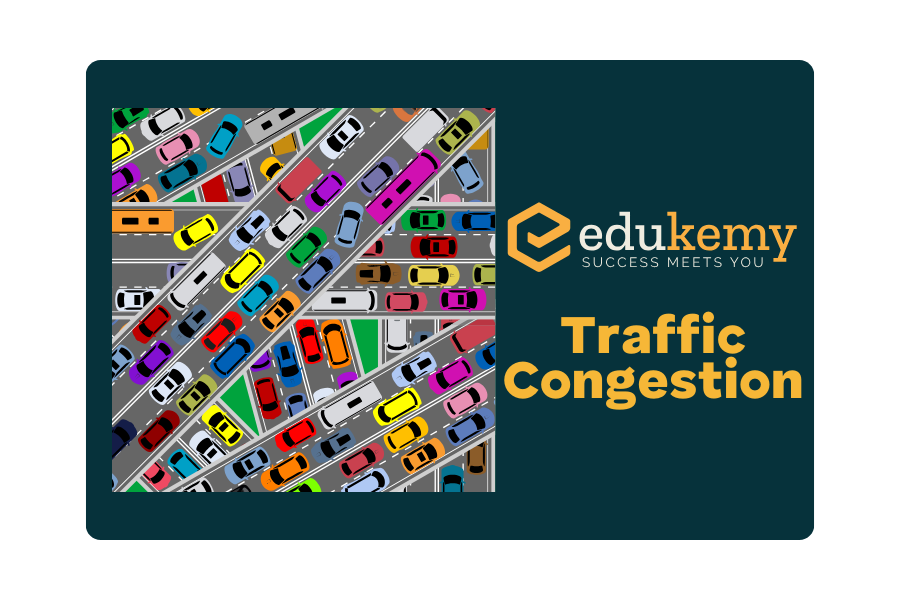
Traffic congestion, a ubiquitous phenomenon in urban areas worldwide, poses significant challenges to commuters, economies, and the environment. The relentless growth of urban populations, coupled with insufficient infrastructure development and increasing vehicle ownership, exacerbates congestion woes. As road networks struggle to accommodate escalating traffic volumes, gridlock becomes a daily reality for millions, resulting in wasted time, productivity losses, heightened pollution levels, and compromised quality of life. Addressing this multifaceted issue demands comprehensive strategies integrating infrastructure improvements, transportation alternatives, and innovative technologies to alleviate congestion’s burdens on society.
Traffic Congestion
- With traffic bottlenecks and traffic congestion, almost all cities and towns of India are suffering from an acute form of transport problem.
- Transport problems increase and become more complex as the town grows in size.
- With its growth, the town performs varied and complex functions, and more people travel to work or shop.
- Due to less penetration of public transport, high-income individuals are buying more private vehicles causing more traffic jams and air pollution, which in turn decreases the efficiency of public transport.
- Also, the penetration of public transport is less, which makes people use a private vehicle instead of Public transport.
- Absence of planned and adequate arrangements for traffic and transport is another problem in urban centres in India. Majority of people use buses and tempos, while a few use rail as transit system.
- The increasing number of two-wheelers and cars make the traffic problem worse. They cause air pollution as well. Moreover, the number of buses plying the metropolitan cities is not adequate and commuters have to spend long hours to travel.
- The design and maintenance of city roads is a major challenge in Indian cities. The roads are notorious for being pedestrian-unfriendly, poorly surfaced, congested, and constantly dug up.
- An important and urgent transformational reform is to draw up national design standards and contracting standards for city roads to address these challenges.
- The flow of traffic also needs special attention in Indian cities. Unlike western cities, motorized vehicles in India change lanes with high frequency and in unpredictable ways. This creates unnecessary traffic jams and delays.
- Metro rails can be an efficient source of public transportation in many cities. The success of some initial metro projects has led to demands for the same in other cities.
FAQs
1. What causes traffic congestion?
- Traffic congestion can be caused by various factors including high volume of vehicles on the road, inadequate infrastructure, road construction, accidents, poor traffic management, and urban sprawl. Additionally, factors like weather conditions and special events can exacerbate congestion.
2. How does traffic congestion affect the economy?
- Traffic congestion imposes significant economic costs, including wasted time and fuel for commuters, increased transportation costs for businesses, and decreased productivity due to delays. It also leads to environmental costs through increased pollution and greenhouse gas emissions.
3. What are some solutions to alleviate traffic congestion?
- Solutions to traffic congestion include improving public transportation systems, implementing congestion pricing schemes, promoting telecommuting and flexible work schedules, investing in infrastructure upgrades, encouraging alternative modes of transportation such as biking and walking, and implementing smart traffic management systems.
4. What are the environmental impacts of traffic congestion?
- Traffic congestion contributes to air and noise pollution, as vehicles spend more time idling and accelerating in congested conditions. This pollution has adverse effects on public health, including respiratory problems and increased risk of cardiovascular diseases. Additionally, congestion contributes to greenhouse gas emissions, exacerbating climate change.
5. How does traffic congestion affect quality of life?
- Traffic congestion reduces quality of life by increasing stress levels, decreasing leisure time, and reducing overall well-being. It leads to frustration among commuters, impacts family and social life, and limits access to essential services. Moreover, congestion-related accidents can result in injuries and fatalities, further diminishing quality of life.
In case you still have your doubts, contact us on 9811333901.
For UPSC Prelims Resources, Click here
For Daily Updates and Study Material:
Join our Telegram Channel – Edukemy for IAS
- 1. Learn through Videos – here
- 2. Be Exam Ready by Practicing Daily MCQs – here
- 3. Daily Newsletter – Get all your Current Affairs Covered – here
- 4. Mains Answer Writing Practice – here

